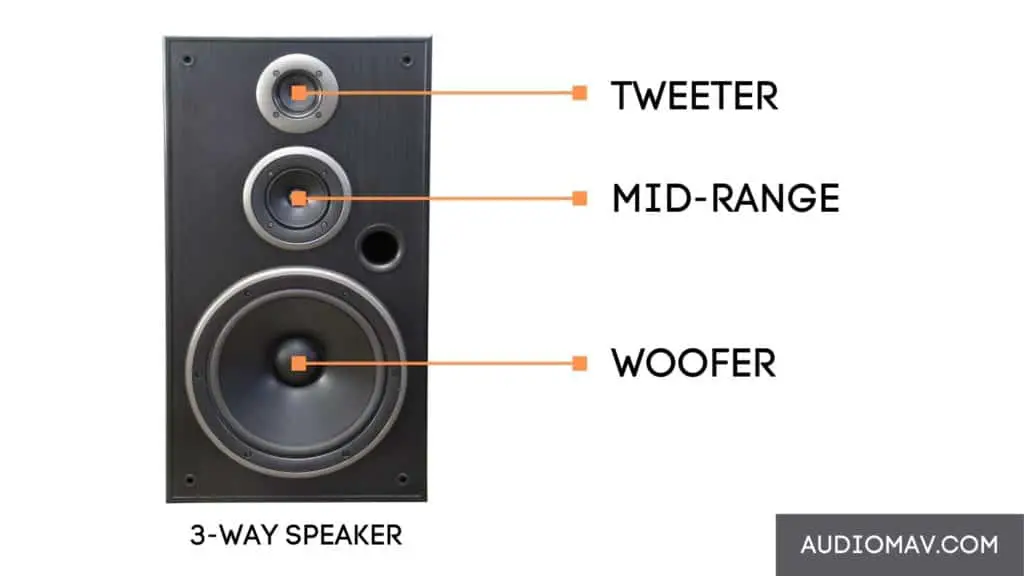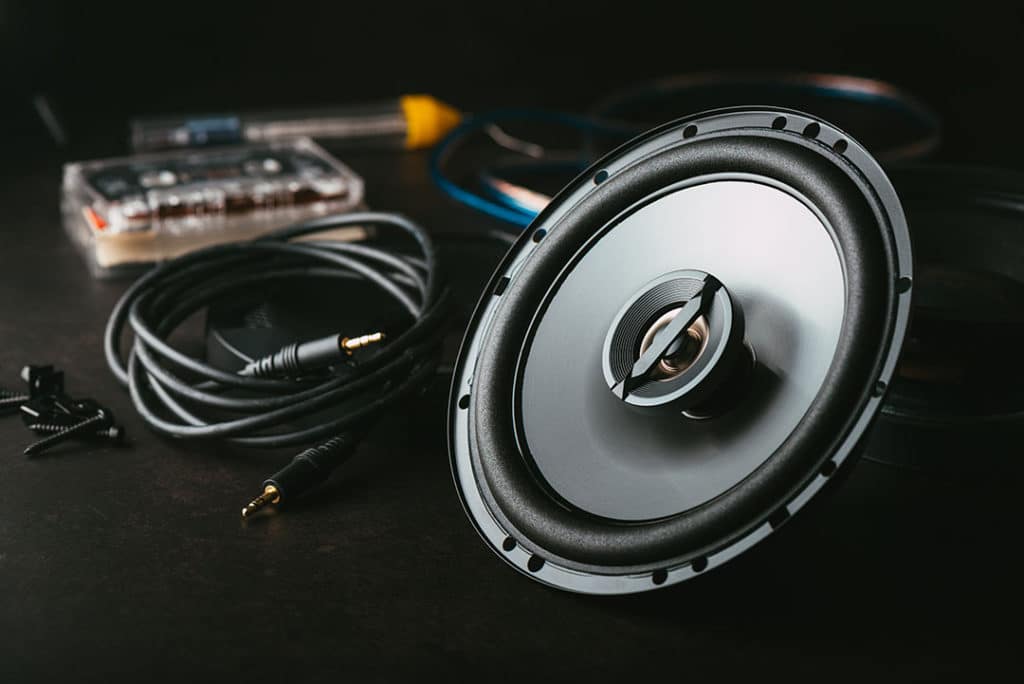The difference between two-way vs. three-way speaker systems involves the number of drivers used in each unit.
How can you tell if you have a two-way or a three-way speaker system?
Two-way speakers use a woofer and tweeter to produce sounds. These dual drivers focus on low- and high-frequency Hertz (Hz) to generate a balanced listening experience. A three-way speaker provides the same experience, adding a mid-range driver to enhance sound equality even further.
Understanding the difference between two-way vs. three-way speaker systems ensures that you receive the precise audio quality needed for any application.
You can find this audio equipment used in various forms, from music production to automobile manufacturing. Both speaker designs are useful when used appropriately.
This guide will take you through the various elements of each speaker and driver to help you determine if a two-way or a three-way design meets your needs.
What Are 2-Way Speakers?

Two-way, or coaxial speakers, are a standardized product found with most entry-level audio systems. The design typically uses a tweeter and a woofer to produce high- and low-frequency sounds in the range of 20 to 20,000 Hz.
The standard Hertz range for two-way speakers depends on the manufacturer. Although most products try to maximize the typical scope of adult human hearing, the audio reproduction doesn’t always fall within the standardized range.
A design that substitutes a mid-range driver for the tweeter or woofer would qualify as a two-way speaker, although that option is uncommon.
The tweeter is the smallest driver, handling the higher frequencies of instruments like the flute or piccolo. It also picks up the high-level tones from the percussion section better, such as the crash of a cymbal or the use of chimes.
Including the woofer in a two-way speaker, design ensures that the bass tones from audio can be heard clearly and accurately. A tuba, bass guitar, and most drum noises require this driver to produce authentic sounds.
A person’s vocal range requires both the tweeter and woofer to sound authentic when speaking or singing. When the frequencies don’t receive accurate representation, this audio sounds hollow.
What Are 3-Way Speakers?
Three-way speakers include a mid-range driver, in addition to a tweeter and woofer. This structure fills in the frequency gaps that appear in the formation of two-way audio equipment to create more sound authenticity. It takes advantage of the subtle differences of the human hearing under 2,500 Hz.
Human hearing is most sensitive to the Hertz range in the middle of the spectrum. That’s why an excellent mid-range driver provides high-quality audio between 250 to 2,000 Hz.
The mid-range driver on three-way speakers is sometimes referred to as a squawker. This nickname comes from the purpose of its inclusion with the audio equipment. Most vocal communication that humans generate falls within this frequency set.
When manufacturers place the squawker on the speaker’s enclosure baffle, the design significantly impacts its output.
The material surrounding the driver can inhibit or create energy reflections from the battle face or other in the cabinet to influence its overall production.
Grills add another dimension to the audio frequencies that your hearing eventually picks up from the speaker.
When the mid-range speaker is in the same container as a woofer, it must have a separate space to operate. Backwave interference from the lower frequencies can wash out the sounds that come from this driver.
That’s why a three-way speaker’s design can be more complicated, especially if the goal is to produce more profound sounds for listening enjoyment.
■ The Different Parts of a 2-Way Speaker

The structure of a three-way speaker always includes a tweeter, mid-range, and woofer. This design ensures that every listener receives a fantastic range of sound at each frequency.
A manufacturer who uses two tweeters and a woofer, or two low-frequency options with one high-range driver are still technically using a two-way design.
▪️ A Woofer
The woofer takes care of the bass load found in the audio. It uses a larger design to create the lower register frequencies that are not always possible with a smaller driver.
When smaller drivers attempt to reproduce low-frequency sounds, the risk of blowing out increases, the inclusion of a woofer virtually eliminates that problem. When it has ample power, you’ll hear authentic sounds instead of popping or distortion.
Woofers might focus on the lower frequencies, but they also improve the performance at the higher Hertz levels.
The longer sound waves needed for bass notes require a majority of the power supplied to the unit.
High-end designs use independent amplification to reduce this load, creating a crossover frequency where the responsibility transfers from one driver to another.
That means the higher frequencies get moved efficiently over to the driver that can produce it better. The three-way speaker design ensures that each driver produces the audio waves it was meant to handle.
This benefit should replicate itself at any volume level if the manufacturing quality meets today’s production standards.
▪️ A Tweeter
Delegating the high-frequency audio reproduction to a smaller driver has several benefits. Because the speaker is more modest, a tweeter requires significantly less power than its counterparts in a three-way design. It also needs less air to make rich, full sounds in the upper levels of the Hertz spectrum.
The standard design for the modern tweeter uses a dome design while sticking to the traditional internal configurations found on more significant drivers.
Although each manufacturer creates a marketing gimmick or small changes to differentiate its branding, stable linear motion, rapid cone movement, and superior dampening require inclusion for the technology to work.
This combination of features creates a balance between the stiffness and lightness of the audio to reduce the risk of distortion.
The diaphragm of a tweeter can be made from almost any woven material. Silk is a popular choice, while aluminum, synthetics, and exotic metals are possibilities. Metal drivers tend to have crisp sounds, while aluminum tends to have more harshness.
Synthetic domes tend to be the least preferred because the material doesn’t dampen well, reducing the authenticity of the sound reproduction.
▪️ A Mid-Range Driver
Did you know that most television sets only use one mid-range driver? If the equipment says that it offers “stereo sound,” it adds a second one for additional support.
The reason why TVs focus on the mid-range driver only is that the Hertz frequencies stay in the sensitive range for human hearing. That’s why music sounds hollow and lifeless when listening to the internal speakers on a television.
Music typically reaches the 20 to 20,000 Hz range of human hearing with its various sounds and instruments. The standard TV using mid-range speakers only has a range of 250 to 2,500 Hz.
The benefit of including a mid-range driver with a three-way speaker design involves the region of audio it produces.
Human hearing picks up subtle discrepancies within that critical range, requiring authentic sounds to reproduce variations with accuracy.
Tweeters and woofers cannot achieve those results because the reproduction is not as faithful.
Most mid-range drivers use a paper cone with resin or polymer surface treatments to reduce vibrations. Carbon fiber, Kevlar, Cobex, and metal alloy designs are also possible because of modern manufacturing practices.
Is a 4-Way Speaker Better than a 2-Way Speaker?
The standard design of a four-way speaker uses two tweeters, a mid-range, and a woofer to create authentic sounds, The additional driver for the high-frequency audio ensures it gets picked up by human hearing as subtle and genuine. A two-way speaker loses support in the mid-range.
A four-way speaker must include a tweeter, mid-range, and woofer. Including four different drivers does not automatically create this design.
If a speaker were to have two tweeters and two woofers, it would still qualify as a two-way design. The different “ways” involve the various frequencies that the drivers target when producing audio.
A four-way speaker could have one tweeter, two mid-range, and one woofer as its design.
It could use one tweeter and mid-range with two woofers.
The sound from a four-way speaker is typically better because it provides a specific emphasis point in a frequency range.
Since human hearing doesn’t pick up higher frequencies well, including two tweeters instead of one creates a fuller sound for the average listener.
Televisions that use four-way speaker technology would use two mid-range drivers to emphasize the speaking element in a broadcast.
Two woofers are useful when the primary audio source features frequencies under 250 Hz.
What Is a Crossover in a Speaker System?
The crossover frequency for a speaker system is the specific audio level where one driver passes the sound to another through filtration. This design ensures that the tweeter, mid-range, or woofer can efficiently receive the appropriate Hz bands (250 Hz and 2,500 Hz) of an audio stream.
Each manufacturer can set its own crossover frequency based on the design of its two-way or three-way speakers.
The THX standard for the crossover, for example, is 80 Hz. Some products allow the user to set their Hertz levels based on their listening preferences manually.
Speakers come with a decibel rating based on the power of the crossover filter.
The standard design uses a three-decibel reduction at the crossover point to ensure there isn’t audio overlap and distortion.
Speakers that use high power levels to produce powerful sounds may increase this feature to six decibels to make sure the audio remains consistent.
If you have manual settings to use, set the crossover point to about 10 Hz above the lowest frequencies, you know the equipment can handle.
2-Way vs. 3-Way in Coaxials

The standard two-way coaxial provides a tweeter and mid-range option for vehicular stereo systems. Although you still hear some bass frequencies, a factory installation often removes the woofer from the setup because of its power requirements. A three-way coaxial adds the woofer component.
The drain on a car battery can be extensive if an audio system with a woofer runs at full power.
That’s why the standard upgrade to car audio is from a two-way coaxial to a three-way system. The change includes an independent amplifier for the woofer to reduce the overall load on the audio structures.
When you move away from the factory install, it is necessary to create an equalization station to ensure the audio remains balanced.
The crossover may get automatically generated by the system itself without this feature, leaving you without many options to create an authentic sound.
What Should I Choose: 2-Way or 3-Way Speakers?
A three-way speaker seems like it has an advantage automatically. Since it includes another driver, it should be better!
Three points of consideration must receive evaluation when selecting a product through the two-way vs. three-way speaker lens.
1. Does the crossover setup split the frequency range between different speakers?
2. What are the manufacturing process and overall craftsmanship of the internal components of the tweeter, woofer, and mid-range drivers?
3. How does the design of the cabinet contribute to the whole audio reproduction?
When a three-way speaker doesn’t address those points adequately, a two-way design can offer superior performance.
Even though it may not have a mid-range, the tweeter and woofer with the latter option can replicate the frequencies with enough accuracy to create authentic sounds.
In most situations, a three-way speaker should outperform a two-way design. It is up to you to ensure the quality of each product’s craftsmanship to make sure that outcome occurs.
A Final Thought on the 2-Way vs. 3-Way Debate
Speakers are a subjective choice. Each person has specific listening objectives to achieve when selecting a two-way vs. a three-way speaker.
The manufacturing quality must be the first focal point. Inferior drivers will always produce subpar sound.
That’s why an excellent two-way speaker sounds better than a lousy three-way design.
Think about your listening needs. Where is the primary Hertz emphasis in the audio? When you can answer that question, select the speaker that provides the most support in that area.

